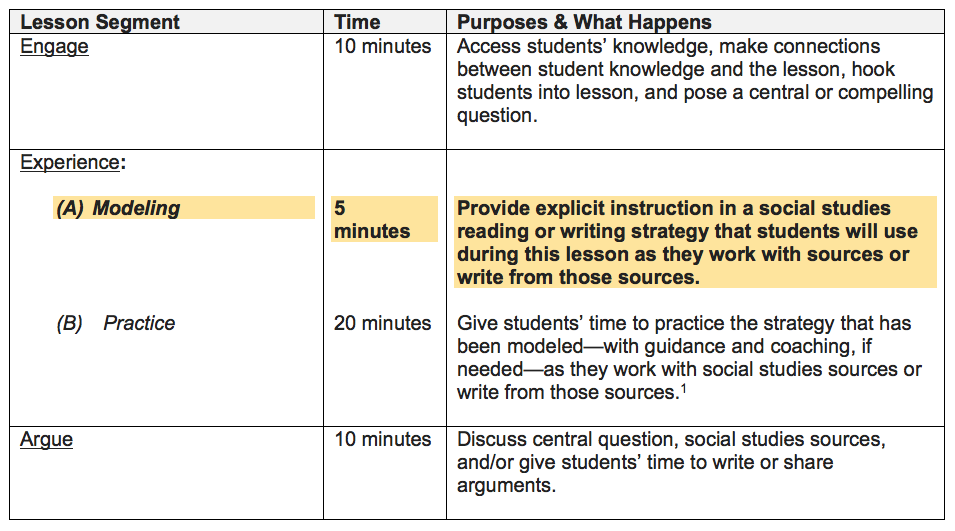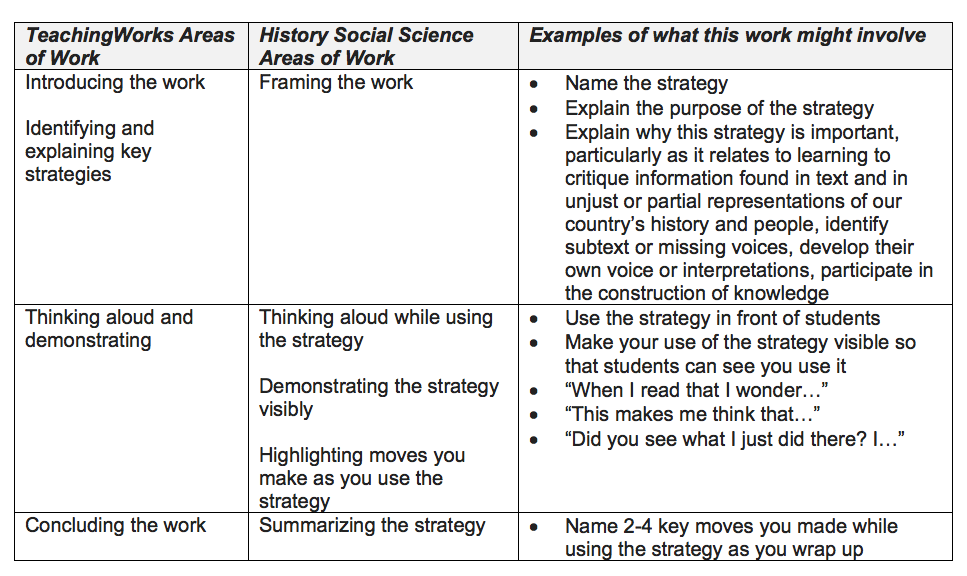What is explaining and modeling content in social studies?
Modeling is a short but important part of inquiry lessons in social studies that prepares students to think critically and develop their own voice as they work with complex texts and communicate their thinking. Modeling is embedded in cognitive apprenticeships, which involve teachers “apprenticing” students into the important thinking work of a given subject area by making their thinking visible and coaching students as they develop expertise (Collins, Brown, & Holum, 1991). Modeling is the first key step in a cognitive apprenticeship, so that the focal strategy is clear and visible to students. When modeling in social studies, teachers make disciplinary reading and writing strategies explicit for students, so that students are empowered to use these strategies in their work regularly and with independence. Our thinking about modeling is shaped by our earlier involvement in the Core Practice Consortium and the Stanford Teacher Education Program.
The strategies we suggest modeling reflect the practices of experts, give students access to ways of thinking that enable them to be savvy consumers of information, provide tools for students to develop their own ideas while being fully informed, and highlight communication and argumentation practices often required for advancement in school. Modeling can focus on history-social science reading practices such as sourcing, contextualization, and corroboration, or writing strategies that help students develop evidence-based interpretations and communicate arguments effectively to various audiences. Through modeling we aim to provide students with strategies and tools that they can apply to many texts and topics as they explore questions of interest, rather than hand them a set of fixed information.
Modeling should always be paired with guided practice or coaching to support students in trying out the strategy and working toward independence. We share materials to support novices’ learning of coaching in our resources on supporting small group work.
How can explaining and modeling content advance justice?
Effective modeling advances justice because it gives all students access to the ways of thinking required to construct their own opinions and become critical consumers of information in the world around them. Students deserve to see examples of how adults interact with text. Modeling intellectual work advances justice by supporting students as they develop the thinking practices necessary to question and challenge information rather than accepting it as truth, and to develop their own ideas and voice. Modeling also can help students decode difficult documents that can form barriers to power and liberation and give students opportunities to develop advanced literacy practices that are crucial to success in school.
Why work on explaining and modeling content?
In history and the social sciences, students must read and write in ways that may be unfamiliar. Modeling can help students understand the ways historians and social scientists approach and compose text. From using attribution information to considering the prevailing notions of a particular context, students who have access to models of historical thinking will begin to interact with documents from the past in ways that help them uncover their meaning and develop their own interpretations of the past and present. Social studies writing requires writers to first sift through many different sources, then develop, plan, and compose a compelling narrative or argument that is grounded in evidence. This work can be highlighted through modeling of social studies writing strategies.
What is the role of explaining and modeling content in the social studies classroom?
Social studies inquiry lessons ideally give students opportunities to Engage in the inquiry, Experience analyzing social studies artifacts, and Argue their ideas through discussion or writing (a.k.a., the “EEA,” framework). We recommend that modeling take place in the first 3-5 minutes of the Experience portion of a lesson so that students are prepared to work with social studies artifacts or develop arguments. The chart below shows how these 3-5 minutes might fit into a 45-minute lesson using the Engage-Experience-Argue (EEA) framework. Alternatively, modeling could be interspersed in 1-minute snippets throughout the Experience portion of an inquiry lesson, so that students see a smaller aspect of a strategy modeled, try it out, see another aspect of a strategy modeled, try it out, etc. It is important to pair modeling with guided practice (or, coaching) and, eventually, independent practice, so that students learn to use the strategies modeled independently. Materials to support novices learning of coaching can be found in the TeachingWorks module on supporting small group work.

How do we decompose the practice into learnable parts?
The practice of explaining and modeling content is broken down into learnable and teachable components, as represented in the decomposition chart below.
Decomposition of practice:
How do we support novices in learning to lead group discussion?
Novices benefit from seeing clear examples of modeling through classroom video. They can also learn about modeling through analyzing modeling scripts and constructing their own scripts. Novices might also practice modeling through rehearsals with their peers in class. We also include field assignments in our resource compilation with the belief that live practice with students and analysis of their enactments are integral parts of learning to model.
Novices often struggle with modeling because they prefer to interact with students rather than provide short, coherent models of thinking without calling on students. When novices are able to focus on modeling, they may not define the strategy they are modeling specifically enough, or they may extend modeling well past 3-5 minutes in an effort to be explicit and thorough, and because they may be new to the content or strategies. However, with feedback from teacher educators and peers, novices can significantly improve their ability to do this work by refining their focus and modeling more strategically.